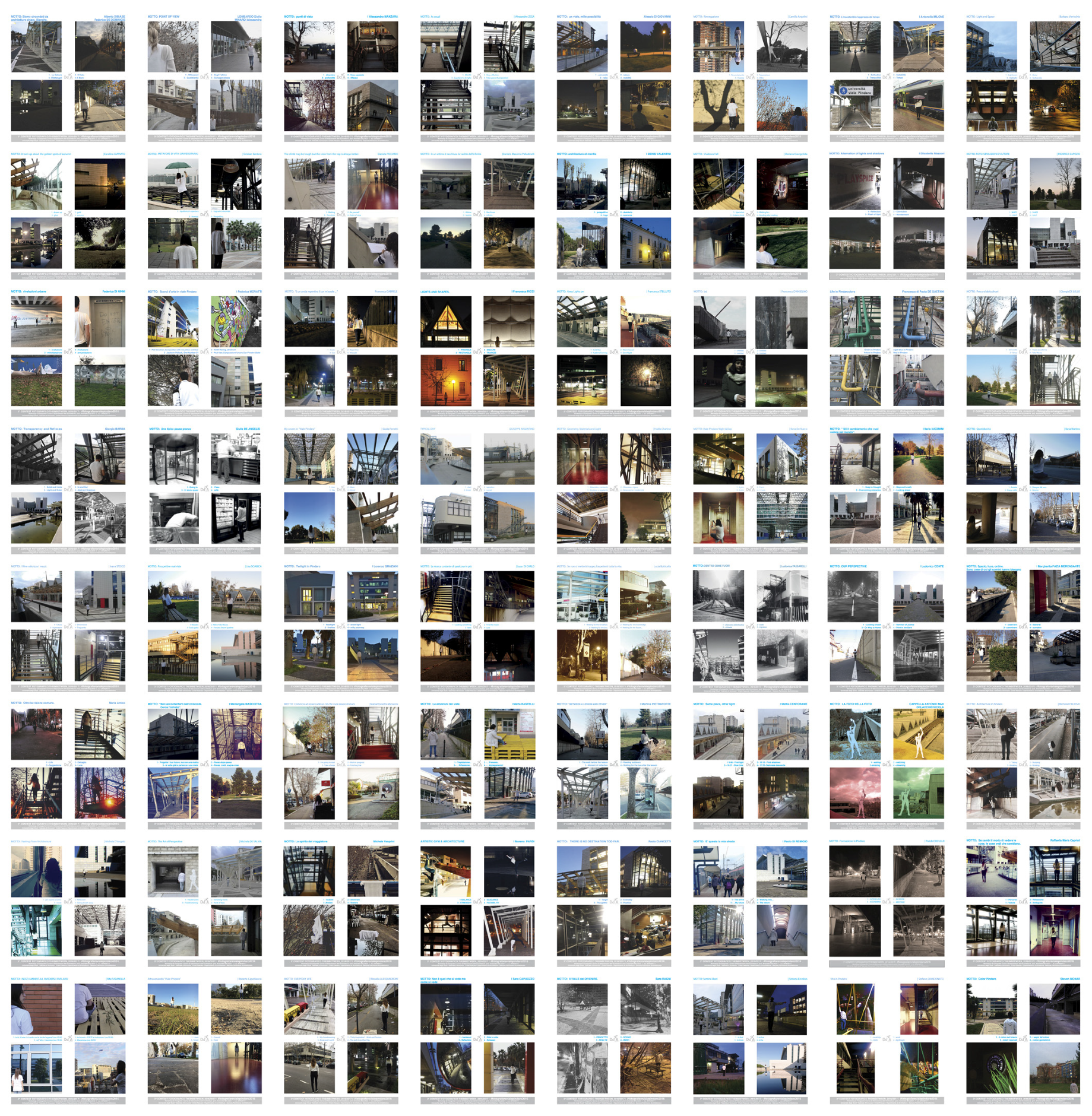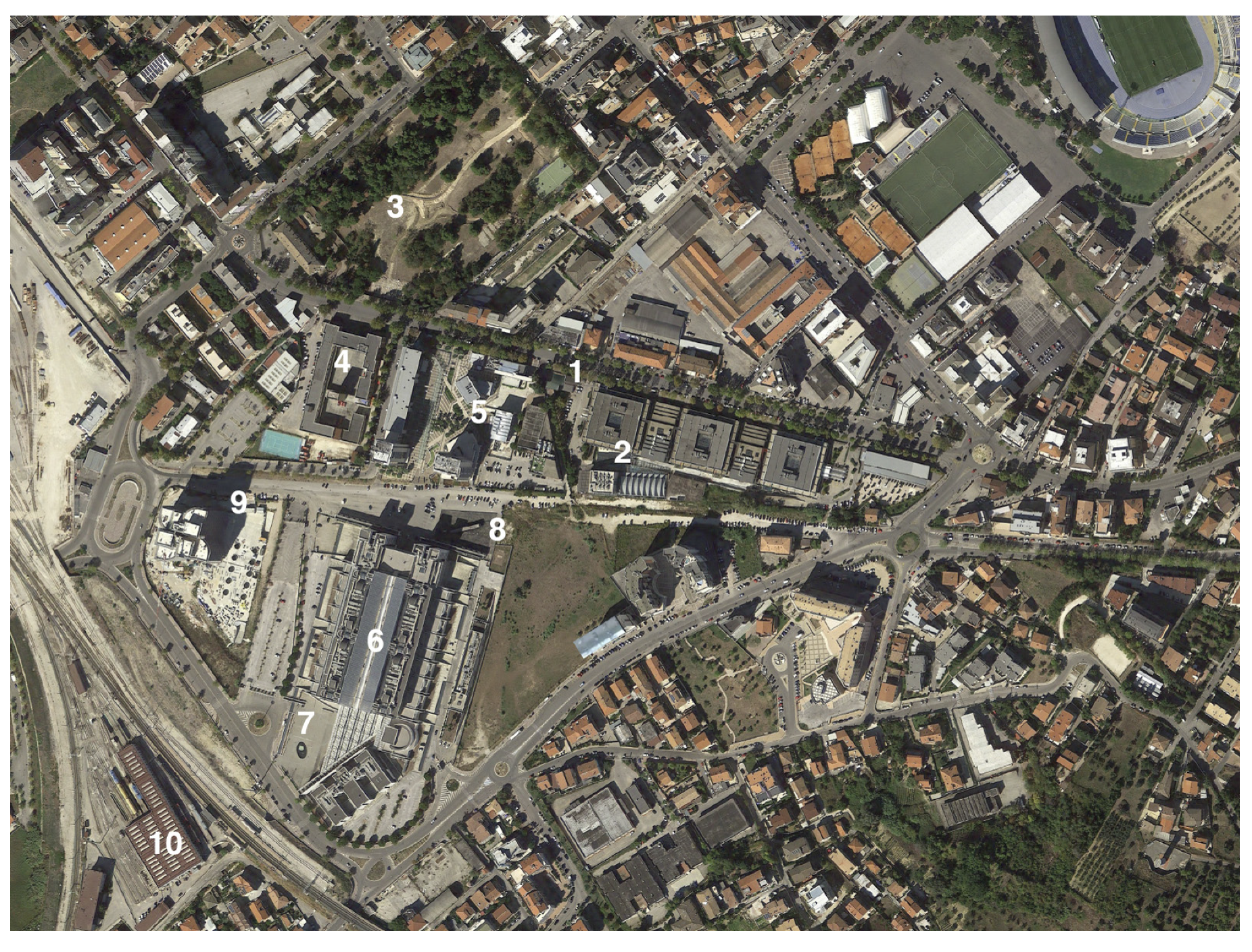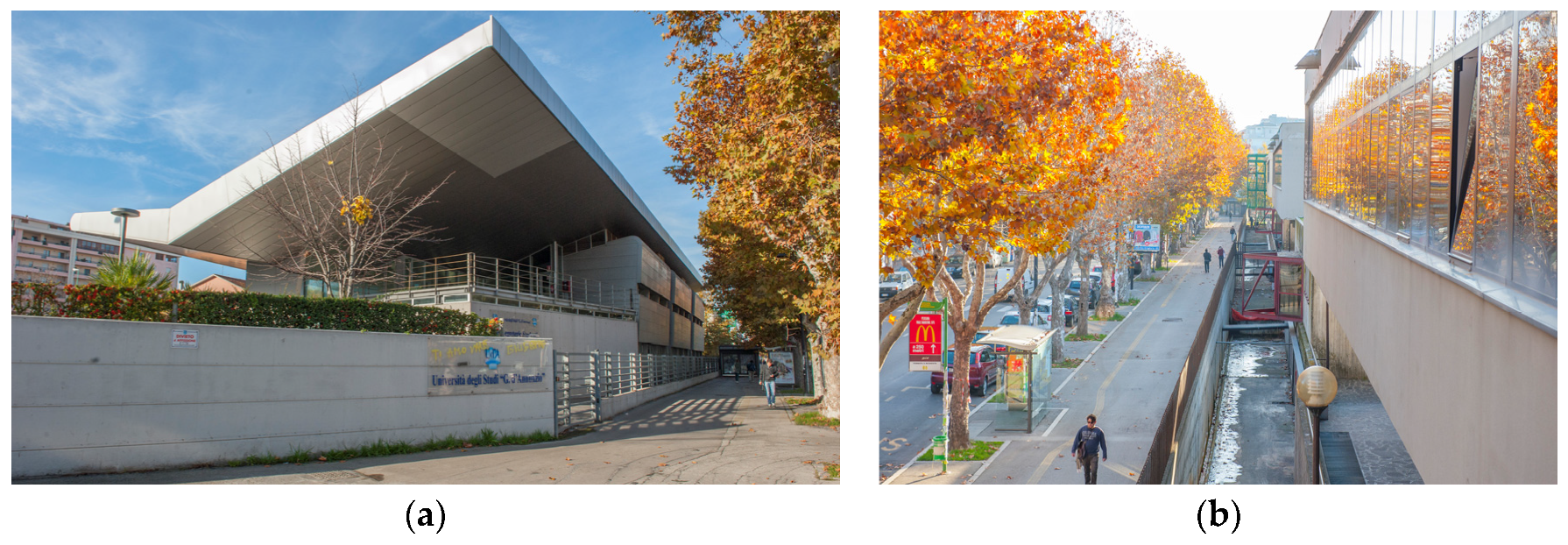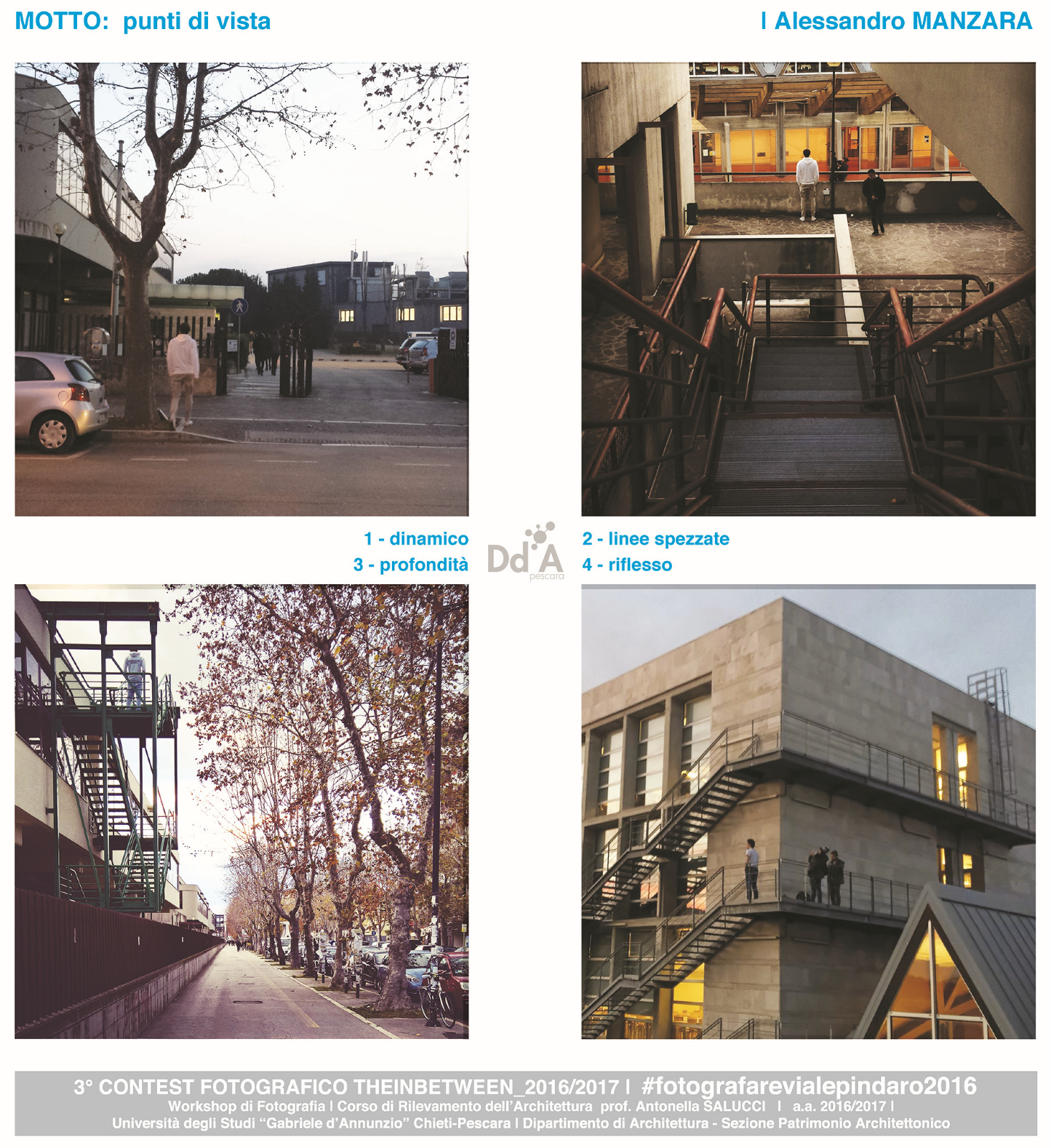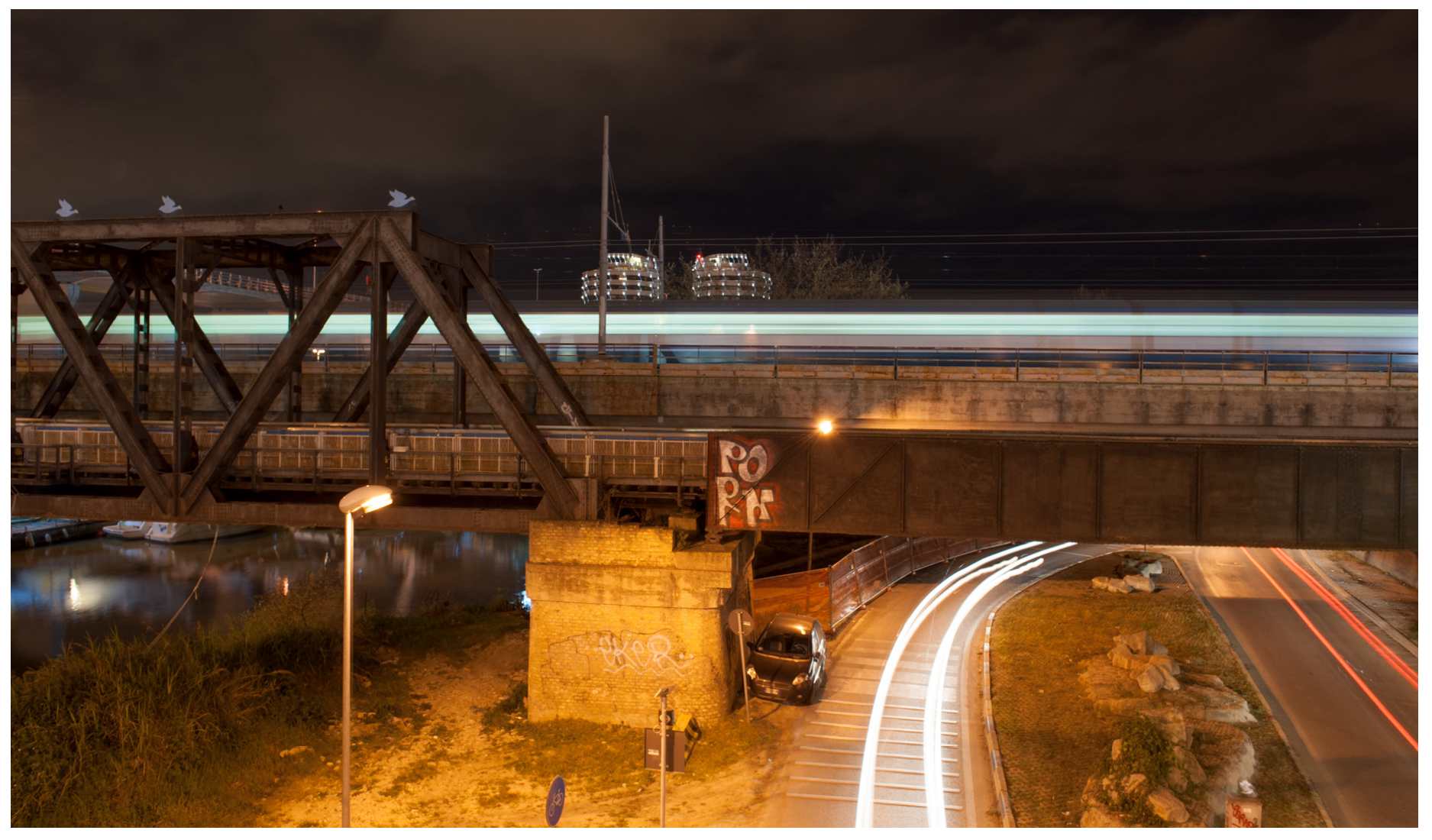1. Introduction
This paper proposes a summary of the results of a research campaign on the Adriatic city of Pescara, specifically referring to its university district and aiming to explore some of its distinguishing features. The study seeks to investigate these urban spaces, taking advantage of the representation made possible through the medium of photography, a mode of observation that is increasingly present in current orientations of the culture of the urban project. This contribution reflects specifically the desire to preserve and pass on the shared memory of a narrative by means of mobile-photography and deal with a medium that has never been so popular as now.
The main lines of investigation, consequential and interrelated, are accompanied by depictions of different points of view, that tell us about shared urban spaces. A summary of the city’s chromatic expression is proposed, enabling you to map the texture and colour of a complex, uneven territory that is continually-transforming and extremely interesting. On the one hand, there are a selection of images, captured whilst passing through the historic part of the city; on the other hand there is a story told through photographs of the urban, university spaces, the Polo Pindaro.
The coastal city of Pescara was founded in 1927, unifying of two municipalities established on the river of the same name. The city presents many conflicting aspects that are juxtaposed as non-exhaustive colour notes,—think of Ettore Sottsass’s ‘Pictures from a window’—from the notebook of a traveller who is passing through [
1]. The research is aimed at observing the architectural spaces of the university district through a series of workshops for architecture students led by the writer, dedicated to surveying and taking photos of architecture. The collective spaces of movement, rest, entertainment, meeting, socialising, waiting, and relaxing, are fixed on the sensor by the same users of those spaces, witnessing a collective way of living. This result is a visual system composed of fragments and impressions that highlight the habits and aesthetic tendencies of the main ‘inhabitants’ of the university district. The adopted methodologies can be summarised using two main processing spheres: on the one hand, the survey and representation of the main axis of the university district, Viale Pindaro; on the other hand, the process of photographic analysis and reflection of the collective urban spaces in the university district.
In this scenario, the research aims to contribute, through unusual points of view, to the documentation of the unpublished aspects of an Italian university district (
Figure 1).
It has the dual objective of detecting the common traits of different spaces in the contemporary city and affirming some of the distinguishing features of this young and complex foundation city. It is useful to highlight the fact that the MiBACT Ministry of Heritage, Culture and Tourism decreed the States General for Photography, on 6 April 2017, in order to: “Protect, enhance and promote photography in Italy as historical heritage and a contemporary language, storage medium, means of expression and understanding of reality, useful for fostering inclusion and increasing individual critical awareness on the part of citizens. The aim is to define a development plan aimed at adapting public actions to the technical and economic changes in the industry and create new opportunities, nationally and internationally, for Italian photography” [
2,
3].
2. Drawing Pescara’s University District with the Mobile-Photography
Like many New Cities created in Italy in the Twentieth Century, and many other examples of urban settlements built in the Fascist period, interpreting the city allows us to detect anomalies that can be attributed to the process of urban planning linked to the utopian sphere, calling for a type of reflection that has to do with its immediate realization.
Organised in a north-east-south-west layout, like all linear cities on the Adriatic coast, Pescara is marked by a continuous urbanisation that has been summarised by Livio Sacchi: “a true linear system, made up of medium-small and very small coastal cities almost all of which have merged into each other. (…) on the Adriatic coast, everything seems to cross over a narrow ‘corridor’ that struggles to house urban, industrial and tourist areas, as well as a considerable amount of infrastructure (…) the flat space along the coast is essentially very slim, enclosed by the sea to the northeast and the mountains to the southwest. In the section in Pescara, there are only a few kilometres separating the sea from the ridge of the highest mountains on the Italian peninsula, such as Maiella and Gran Sasso. (…) This is a widespread urban system that, whether we like it or not, definitively puts our historical notion of the city in crisis” [
4].
Dominated for centuries by the Carlo V’s polygonal fortress to guard the mouth of the river that marks the boundary between the two provinces of the Abruzzi, —Abruzzo Ultra to the north and Citra to the south—the new Pescara, in the province of Chieti, was founded in 1927 by merging the rural centre with Castellammare Adriatico on the other side of the river, which belonged to the province of Teramo.
The birth of modern Pescara is linked to the growing importance of the strategic role of settlements along the Adriatic coast, set in a system of connected national infrastructure, joining the Adriatic line with the road across the Apennines to Rome.
The arrival of the railway brought ‘new functions’ to the coast linked to the use of the coast as a seaside destination, as Antonello Alici has pointed out: “in under a century, the lives and signs of many cities pass by and settle down. The city of pioneers who arrived on the railway, the city of tourism and swimming in the sea (…) the garden city with the wide streets lined with slender young trees and two-story houses and villas, the city of the palaces of power that interpret the rhetoric of the Fascist regime, the city of cars home to the Coppa Acerbo circuit (…) the city which was swept away and disfigured by the American bombs and the German mines. The city that is still green and measured by the houses for the homeless and the popular neighbourhoods, the city of elegant apartment blocks (…) the city that grows dense without order or decorum until the coast and the hills are saturated” [
5].
A complexity that persists but that has assumed a precise direction that we find in a piece of writing from a decade ago by Alberto Clementi, who was at that time the head of the Faculty of Architecture: “even a few years ago, the types of architecture in a rapidly changing city such as Pescara had little in common with works produced by the university. On the one hand, there is a construction industry that is voracious and unbridled like a foam that is as porous as it is dense. On the other hand, there is a school of architecture reaching out to the values of contemporaneity in the new state, explored through the forms of the infinite city on the Adriatic coast and the accumulation of low-quality infrastructure (…) two worlds have begun to come closer (…) helping to regenerate the public spaces and voids in the city centre…) giving impetus to new centres in semi-peripheral areas within the consolidated city. Particularly in a marginal area, where the d’Annunzio University was pioneeringly established over twenty years ago, under the guidance of a controversial program agreement they are focusing on important public functions, such as the newly completed judicial area and other profitable private real estate initiatives, aimed at capturing the strong positional value acquired by this strategic area for the future of the city” [
6] (
Figure 2).
The university district, the University of Annunzio’s Polo Pindaro, is located in the southern quadrant of the city, near the Pineta Dannunziana, established along the stretch that leads to the sea Viale Pindaro is an approximately 700-m long axis where various educational and research Department buildings of the ‘Gabriele d’Annunzio’ University in Chieti-Pescara are situated, including Architecture, Engineering, Economics, and Languages.
The so called Polo Pindaro is a complex urban area where the dynamics of the everyday activities of the students of the school of Architecture take place (
Figure 2 and
Figure 3a,b). A type of boulevard that is home to several spectacular specimens of sycamore trees, Viale Pindaro represents one of the stretches of a larger area of around 30 hectares with interesting features. Among these features we will observe: the position near Pineta Dannunziana, the city’s “green lung”; the presence of the ex-Caserma “Di Cocco” park; the area adjacent to the new Piazza Accademia; the proximity of Pescara Tribunale railway station to the railway line and the monolithic spaces of the Court of Pescara, which are home to two important installations—“Omaggio a Nassyria” by the architect Giangiacomo D’Ardia (2005) and the “Disco” fountain by the artist Ettore Spalletti (2004).
With regard to this work, as far as this discussion is concerned, it seems appropriate to point out what has been said by the artist Ettore Spalletti—he has recently received the Laurea Honoris Causa from the School of Architecture in May 2017—thought of this sculpture specifically in terms of ‘light and colour’, he defines it as a black disc, a mirror of water, that: “is there to remind us of Pescara’s light, articulating each hour through its reflection, showing us different pictures and colours at different hours of the day. When the light is going down, it takes on an elliptical shape until it is illuminated at night” [
7].
The photography workshop ‘#theinbetween’, now in its fourth edition, is a seminar organised for architects enrolled in the first and second year; it is aimed at awareness, observation, and prefiguration of the architecture and the environment and it is built through the medium of mobile-photography (
Figure 1,
Figure 4 and
Figure 5).
A visual narrative of everyday places, the places that are frequented by students, related to university activity, throughout the day.
The seminar, which results in series of compositions related to poetics of storytelling, reconstructs some of the phases of the daily experience of the authors/students/architects/photographers of the Pescara School of Architecture.
The investigation is conducted using the mobile-photography technique, and is therefore quick, instinctive, spontaneous, and creative.
A way to survey and represent collective spaces—of movement, rest, fun, meeting, socializing, waiting, and relaxing—through which it is possible to retrace various singular dynamics observed and fixed on the digital sensor from a privileged point of view.
The results of the survey of these spaces of movement, make up a fascinating visual system, inside which there are various recognizable hints of aesthetic inclinations, of cultural attitudes, logistical needs, and student attendance and habits.
From a personal point of view through mobile-photography, students survey the space of the city that they live in and produce an innovative piece of visual work that tells us about a dialogue or an interaction, that is attributed to a sort of conceptual work that is put forward again like in a visual atlas, the significant blocks of the everyday life of the Architecture students.
As part of our survey, we aim to creatively explore a collective space by experimenting with the capture of a temporal fragment, the testimony of collective living, with an everyday tool like the smart-phone.
With the objective of detecting and representing, through taking photographs of various urban spaces, the student is required to design and think of keywords and photographic images—a sort of story-telling—that are representative of the personal way of ‘living’ Viale Pindaro, the avenue adjacent to the university buildings in Pescara.
This is in order to portray various aspects connected to the everyday use of a number of connective spaces ‘between’ the environments where studying activities take place (
Figure 3a,b).
Since every student has access to a smartphone, this tool for taking photographs has been chosen as it provides a level playing field to compare the work.
The technique of taking photos with an iPhone is based solely on attitudes, sensitivity, and perceptual aspects; it allows you to make notes and observations with images in complete freedom; to experiment with ‘visions’, freeing ourselves from a traditional approach to photography in favor of greater creativity and perceptual openness [
8].
This position allows those who are starting to observe architecture to get away from any technical or technological constraints, in favor of a better understanding and interpretation of the architectural subject.
Choosing the mobile-photography, the smart phone, to make edits, do retouches, and share the images from the survey and documentation in an area of study is an unconventional yet widespread approach to digital photography.
In traditional digital shooting techniques, the photograph is mainly processed once it has already been taken, in so-called ‘post-production’.
This is where the crude, raw NEF/RAW file is taken and the digital negative is transformed into a photograph.
Photographing with the smart phone allows and forces preliminary decisions to be made at the same time.
A type of ‘constraint’ that facilitates the assessment of the scenario ahead, and invites the observer—the student architect, researcher, photographer, iPhoneographer—to prefigure the final result before taking it.
Mobile-photography is a mode of representation that creates freedom of choice and, above all, allows a free and creative approach to research. Stimuli, intuitive conditioning that simultaneously allows the personal photographic model to be composed in that articulated and instinctive interaction between observation, comprehension, imagination, and intention.
Detect and represent, through some photographic images, the places that are frequented by student-architects, related to university activity, throughout the day.
The students are required to design a four-step sequence—combined with key words that make up the motto of the project—that is representative of their personal ‘way of life’ on viale Pindaro: planning a story that gives meaning to the images; take four 1:1 format pictures that include an avatar subject in a white t-shirt, taken from behind; identify four keywords that create a motto; share on Instagram, tag #fotografarevialepindaro (
Figure 5).
The workshop in the form of the photographic contest has allowed an unpublished and interesting view of the urban landscape that characterizes the university district of Polo Pindaro, which is made up of an architectural matter that we could define as various and sometimes conflicting. Peculiar activities of making Photography and, more generally, of Representing.
